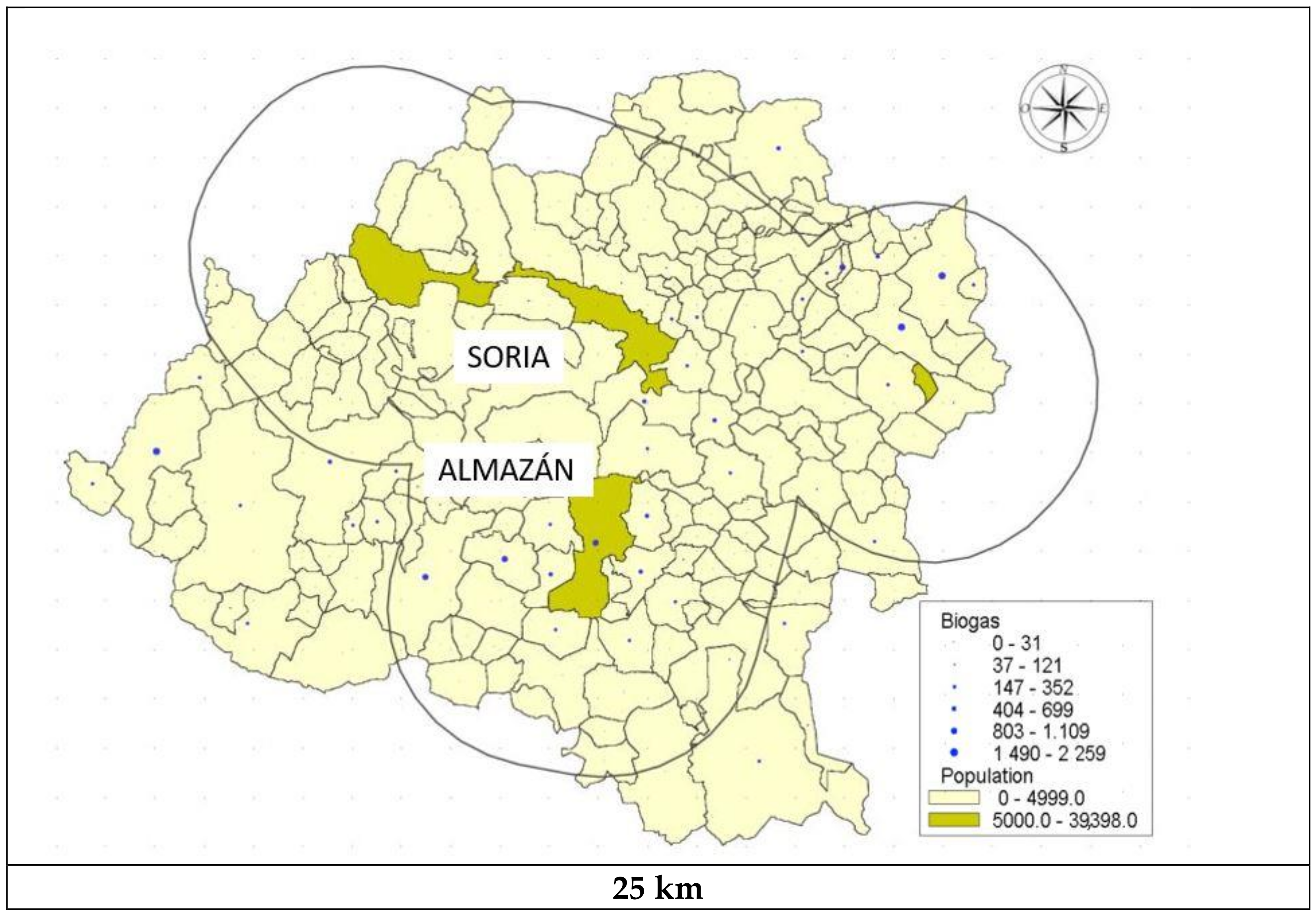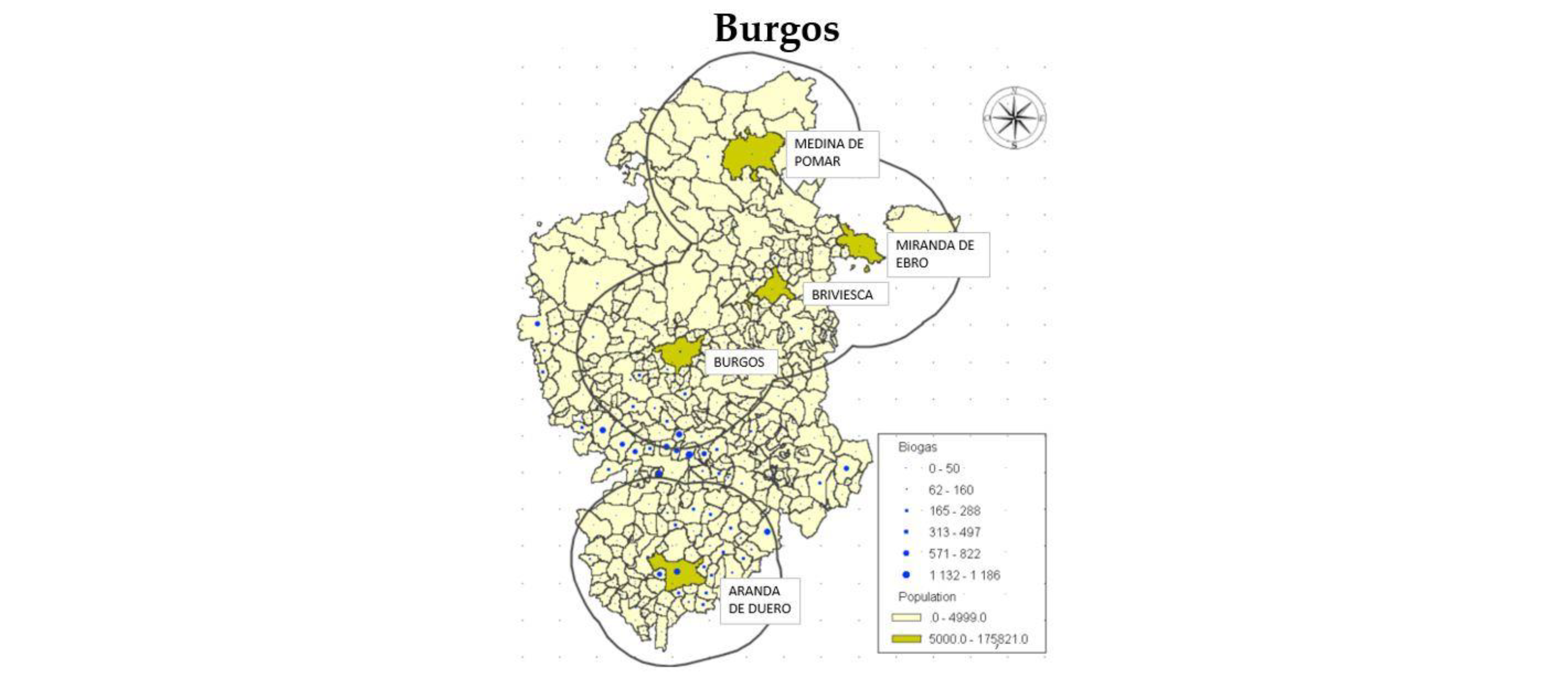A Distributed Biogas Production Model and Its Use in the Livestock Sector. Case Study: Castile and León
Abstract
:1. Introduction
2. Materials and Methods
2.1. Castile and León and the Porcine Population
2.2. Pig Farm to Produce Manure
3. Results
Georeferenzing of Biogas in Each Province Studied
- Scope and growth of the pig herd; a parameter that evaluates the variation and impact of the distributed biogas generation model versus the availability of organic matter.
- Biogas production, based on the lower heating value (kWh/m3), considering the variation of the biogas capacity and the organic matter content (0.05 and 0.15 m3/animal) (LIFE SMART AgroMobility).
- Natural gas cost evolution to generate electricity (big consumers), considering the historic prices during the 2015–2020 period.
- CO2 cost evolution in the first quarter of phase IV of the EU emissions trading system.
4. Conclusions
Author Contributions
Funding
Institutional Review Board Statement
Informed Consent Statement
Data Availability Statement
Acknowledgments
Conflicts of Interest
References
- Worldometer. World Population Clock: 7.8 Billion People (2021). Available online: https://www.worldometers.info/ (accessed on 26 February 2021).
- Statistics. Eurostat 2021. Available online: https://ec.europa.eu/info/statistics_en (accessed on 26 February 2021).
- European Commission. Demographic Trends in EU Regions. Available online: https://ec.europa.eu/regional_policy/en/newsroom/news/2019/01/31-01-2019-demographic-trends-in-eu-regions (accessed on 26 February 2021).
- The World Bank. Urban Population (% of Total Population)–European Union. Available online: https://data.worldbank.org/indicator/SP.URB.TOTL.IN.ZS?locations=EU (accessed on 26 February 2021).
- National Oceanic and Atmospheric Administration. Global Monitoring Laboratory–Carbon Cycle Greenhouse Gases. Available online: https://www.esrl.noaa.gov/gmd/ccgg/trends/monthly.html (accessed on 31 March 2021).
- NASA Climate Change. Available online: https://climate.nasa.gov/ (accessed on 31 March 2021).
- Statistics Explained. Agricultural Production–Livestock and Meat. Available online: https://ec.europa.eu/eurostat/statistics-explained/index.php?title=Agricultural_production_-_livestock_and_meat&oldid=470510 (accessed on 26 February 2021).
- Hegg, R. Manure management in North America: Management and future trends. In Libro de Actas del I Congreso Español de Gestión Integral de Deyecciones Ganaderas; Magrí, A., Prenafeta-Boldú, F.X., Flotats, X., Eds.; Fira de Barcelona: Barcelona, Spain, 2008; pp. 3–10. [Google Scholar]
- Food and Agriculture Organization of the United Nations. Livestock Primary. Available online: http://faostat.fao.org/site/569/default.aspx (accessed on 29 March 2021).
- Zengwei, Y.; Pan, X.; Chen, T.; Zhang, Y.; Jiang, S.; Sheng, H.; Zhang, L. Evaluating environmental impacts of pig slurry treatment technologies with a life-cycle perspective. J. Clean. Prod. 2018, 188, 840–850. [Google Scholar] [CrossRef]
- Martinez, J.; Burton, C. Manure management and treatment in Europe: A review on environmental, technological and policy perspectives. In Libro de Actas del I Congreso Español de Gestión Integral de Deyecciones Ganaderas; Magrí, A., Prenafeta-Boldú, F.X., Flotats, X., Eds.; Fira de Barcelona: Barcelona, Spain, 2008; pp. 257–272. [Google Scholar]
- de Gregorio, M. Biomasa en España. Generación de Valor Añadido y Análisis Prospectivo; Fedea: Madrid, Spain, 2020. [Google Scholar]
- Bernet, N.; Béline, F. Challenges and innovations on biological treatment of livestock effluents. Bioresour. Technol. 2009, 100, 5431–5436. [Google Scholar] [CrossRef] [PubMed]
- Brockmann, D.; Hanhoun, M.; Negri, O.; Helias, A. Environmental assessment of nutrient recycling from biological pig slurry treatment-impact of fertilizer substitution and field emissions. Bioresour. Technol. 2014, 163, 270–279. [Google Scholar] [CrossRef] [PubMed]
- Lopez-Ridaura, S.; Werf, H.; Paillat, J.M.; Le Bris, B. Environmental evaluation of transfer and treatment of excess pig slurry by life cycle assessment. J. Environ. Manag. 2009, 90, 1296–1304. [Google Scholar] [CrossRef] [PubMed]
- Prapaspongsa, T.; Christensen, P.; Schmidt, J.H.; Thrane, M. LCA of comprehensive pig manure management incorporating integrated technology systems. J. Clean. Prod. 2010, 18, 1413–1422. [Google Scholar] [CrossRef]
- European Commission. Directive 91/676/EEC of 12 December 1991 Concerning the Protection of Waters against Pollution Caused by Nitrates from Agricultural Sources; European Commission: Brussels, Belgium, 1991. [Google Scholar]
- Palese, A.M.; Persiani, A.; D’Adamo, C.; Pergola, M.; Pastore, V.; Sileo, R.; Ippolito, G.; Lombardi, M.A.; Celano, G. Composting as Manure Disposal Strategy in Small/Medium-Size Livestock Farms: Some Demonstrations with Operative Indications. Sustainability 2020, 12, 3315. [Google Scholar] [CrossRef] [Green Version]
- Flotats, X.; Bonmatí, A.; Fernández, B.; Magrí, A. Manure treatment technologies: On-farm versus centralized strategies. NE Spain as case study. Bioresour. Technol. 2009, 100, 5519–5526. [Google Scholar] [CrossRef] [PubMed]
- Rico, C.; Montes, J.A.; Rico, J.L. Evaluation of different types of anaerobic seed sludge for the high rate anaerobic digestion of pig slurry in UASB reactors. Bioresour. Technol. 2017, 238, 147–156. [Google Scholar] [CrossRef] [PubMed] [Green Version]
- Fangueiro, D.; Hjorth, M.; Gioelli, F. Acidification of animal slurry-a review. J. Environ. Manag. 2015, 149, 46–56. [Google Scholar] [CrossRef] [PubMed]
- Lymperatou, A.; Rasmussen, N.B.; Gavala, H.N.; Skiadas, I.V. Improving the Anaerobic Digestion of Swine Manure through an Optimized Ammonia Treatment: Process Performance, Digestate and Techno-Economic Aspects. Energies 2021, 14, 787. [Google Scholar] [CrossRef]
- Djelal, H.; Tahrani, L.; Fathallah, S. Treatment process and toxicities assessment of wastewater issued from ananerobic digestion of household wastes. Environ. Sci. Pollut. Res. 2014, 21, 2437–2447. [Google Scholar] [CrossRef] [PubMed]
- Nasir, I.M.; Ghazi, T.I.M.; Omar, R. Anaerobic digestion technology in livestock manure treatment for biogas production: A review. Eng Life Sci 2012, 12, 258–269. [Google Scholar] [CrossRef]
- Eurobser, E.R. Biogas barometer 2017. Available online: https://www.eurobserv-er.org/category/all-biogas-barometers/ (accessed on 31 January 2021).
- Mao, C.; Feng, Y.; Wang, X.; Ren, G. Review on research achievements of biogas from anaerobic digestión. Renew. Sustain. Energy Rev. 2015, 45, 540–555. [Google Scholar] [CrossRef]
- Yentekakis, I.V.; Goula, G. Biogas management: Advanced utilization for production of renewable energy and added value chemicals. Front. Environ. Sci. 2017, 5, 1–7. [Google Scholar] [CrossRef] [Green Version]
- Xu, J.; Adair, C.W.; Deshusses, M.A. Performance evaluation of a full-scale innovative swine waste-to-energy system. Bioresour. Technol. 2016, 216, 494–502. [Google Scholar] [CrossRef] [PubMed] [Green Version]
- Clemens, J.; Trimborn, M.; Weiland, P.; Amon, B. Mitigation of greenhouse gas emissions by anaerobic digestion of cattle slurry. Agric. Ecosyst. Environ. 2006, 112, 171–177. [Google Scholar] [CrossRef]
- Ministerio para la Transición Ecológica y el Reto Demográfico. Hoja de Ruta de Biogás. Available online: https://energia.gob.es/es-es/Participacion/Paginas/DetalleParticipacionPublica.aspx?k=315 (accessed on 15 March 2021).
- Rural Bioenergy. Use of the Biogas Potential in Spain. Available online: https://ruralbioenergy.com/en/2019/04/use-of-the-biogas-potential-in-spain/ (accessed on 15 March 2021).
- USGS, Science for a Changing World. Landfill Leachate Released to Wastewater Treatment Plants and other Environmental Pathways Contains a Mixture of Contaminants Including Pharmaceuticals. Available online: https://www.usgs.gov/ecosystems/environmental-health/science/landfill-leachate-released-wastewater-treatment-plants-and?qt-science_center_objects=0#qt-science_center_objects (accessed on 16 March 2021).
- Campos, E.; Illa, J.; Magrí, A.; Sole-Mauri, F.; Flotats, X. Guía de los Tratamientos de las Deyecciones Ganaderas. In Proceedings of the Generalitat de Catalunya, Barcelona, Spain, 2 April 2004; p. 10. [Google Scholar]
- Yin, N.; An, C.J.; Zhao, K.; An, Y.K.; An, S. Handling of Amine-Based Wastewater Produced During Carbon Capture. J. Environ. Inform. Lett. 2019, 2, 57–69. [Google Scholar] [CrossRef] [Green Version]
- Yao, Y.; Huang, G.; An, C.; Chen, X.; Zhang, P.; Xin, X.; Agnew, J. Anaerobic digestion of livestock manure in cold regions: Technological advancements and global impacts. Renew. Sustain. Energy Rev. 2019, 119. [Google Scholar] [CrossRef]
- Censo de Ganado Porcino en Castilla y León. Available online: https://www.leonoticias.com/campo/censo-ganado-porcino-castilla-leon-20200411124032-in.html (accessed on 16 March 2021).
- Statistics. Eurostat. Cabaña Española de Porcino de Las Distintas Comunidades Autónomas en España. Available online: https://es.statista.com/estadisticas/525960/cabana-espanola-de-porcino-por-cc-aa-en-espana/ (accessed on 16 March 2021).
- Anguix, A.; Díaz, L. gvSIG: A GIS desktop solution for an open SDI. J. Geogr. Reg. Plan. 2008, 1, 41–48. [Google Scholar]
- Dieter, D.; Steinhauser, A. Biogas from Waste and Renewable Resources: An Introduction; Wiley-VCH: Weinheim, Germany, 2008. [Google Scholar] [CrossRef]
- Decorte, M.; Sainz Arnau, A.; Dekker, H.; Pfluger, S.; Giacomazzi, M. Annual Report 2020; European Biogas Association: Brussels, Belgium, 2021. [Google Scholar]
- Factores de Emisión, Registro de Huella de Carbono, Compensación y Proyectos de Absorción de Dióxido de Carbono. Available online: https://www.miteco.gob.es/es/cambio-climatico/temas/mitigacion-politicas-y-medidas/factores_emision_tcm30-479095.pdf (accessed on 22 March 2021).
- SendeCO2. Precios CO2. Available online: https://www.miteco.gob.es/es/cambio-climatico/temas/mitigacion-politicas-y-medidas/factores_emision_tcm30-479095.pdf (accessed on 22 March 2021).







| Province | Area of Influence | Porcine Livestock (Pigs) | Biogas (m3/d) | Production of Biogas (kWh/d) |
|---|---|---|---|---|
| Segovia | Cuellar | 447,612 | 35,808.96 | 225,596.45 |
| Segovia | 119,493 | 9559.44 | 60,224.47 | |
| Soria | Almazán | 113,053 | 9044.24 | 56,978.71 |
| Soria | 195,430 | 15,634.40 | 98,496.72 | |
| Salamanca | Alba de Tormes | 92,725 | 7418.00 | 46,733.40 |
| Ciudad Rodrigo | 20,007 | 1600.56 | 10,083.53 | |
| Guijuelo | 21,599 | 1727.92 | 10,885.90 | |
| Peñaranda de Bracamonte | 70,968 | 5677.44 | 35,767.87 | |
| Salamanca | 47,139 | 3771.12 | 23,758.06 | |
| Zamora | Benavente | 127,353 | 10,188.24 | 64,185.91 |
| Toro | 35,539 | 2843.12 | 17,911.66 | |
| Zamora | 122,087 | 9766.96 | 61,531.85 | |
| Burgos | Aranda de Duero | 100,076 | 8006.08 | 50,438.30 |
| Burgos | 50,193 | 4015.44 | 25,297.27 |
| Province | Area of Influence | Population (Inhabitants) | Energy Demand (kWh/d) | Covered Energy (%) | Sustainable Population (Inhabitants) |
|---|---|---|---|---|---|
| Segovia | Cuéllar | 9583 | 40,980 | 209.2% | 20,047 |
| Segovia | 51,674 | 220,976 | 10.4% | 5352 | |
| Soria | Almazán | 5489 | 23,473 | 92.2% | 5063 |
| Soria | 39,398 | 168,480 | 22.2% | 8750 | |
| Salamanca | Alba de Tormes | 5186 | 22,177 | 80.1% | 4153 |
| Ciudad Rodrigo | 12,344 | 52,787 | 7.3% | 896 | |
| Guijuelo | 5633 | 24,089 | 17.2% | 967 | |
| Peñaranda de Bracamonte | 6260 | 26,770 | 50.8% | 3178 | |
| Salamanca | 144,228 | 616,769 | 1.5% | 2111 | |
| Zamora | Benavente | 17,935 | 76,696 | 31.8% | 5704 |
| Toro | 8713 | 37,260 | 18.3% | 1592 | |
| Zamora | 61,406 | 262,593 | 8.9% | 5468 | |
| Burgos | Aranda de Duero | 32,856 | 140,504 | 13.6% | 4482 |
| Burgos | 175,821 | 751,872 | 1.3% | 2248 |
| Province | Area of Influence | Tonnes (tCO2/year) | Income CO2 (€/tCO2) |
|---|---|---|---|
| Segovia | Cuéllar | 14,986.37 | 560,640.18 |
| Segovia | 4000.71 | 149,666.62 | |
| Soria | Almazán | 3785.10 | 141,600.44 |
| Soria | 6543.14 | 244,778.76 | |
| Salamanca | Alba de Tormes | 3104.50 | 116,139.34 |
| Ciudad Rodrigo | 669.85 | 25,059.04 | |
| Guijuelo | 723.15 | 27,053.04 | |
| Peñaranda de Bracamonte | 2376.06 | 88,888.39 | |
| Salamanca | 1578.25 | 59,042.24 | |
| Zamora | Benavente | 4263.87 | 159,511.38 |
| Toro | 1189.87 | 44,513.09 | |
| Zamora | 4087.56 | 152,915.64 | |
| Burgos | Aranda de Duero | 3350.62 | 125,346.56 |
| Burgos | 1680.50 | 62,867.42 |
Publisher’s Note: MDPI stays neutral with regard to jurisdictional claims in published maps and institutional affiliations. |
© 2021 by the authors. Licensee MDPI, Basel, Switzerland. This article is an open access article distributed under the terms and conditions of the Creative Commons Attribution (CC BY) license (https://creativecommons.org/licenses/by/4.0/).
Share and Cite
Reparaz, C.; Sánchez-Martín, L.; de Godos, I.; Mora, P.; Llamas, B. A Distributed Biogas Production Model and Its Use in the Livestock Sector. Case Study: Castile and León. Appl. Sci. 2021, 11, 5326. https://doi.org/10.3390/app11125326
Reparaz C, Sánchez-Martín L, de Godos I, Mora P, Llamas B. A Distributed Biogas Production Model and Its Use in the Livestock Sector. Case Study: Castile and León. Applied Sciences. 2021; 11(12):5326. https://doi.org/10.3390/app11125326
Chicago/Turabian StyleReparaz, Carlos, Laura Sánchez-Martín, Ignacio de Godos, Pedro Mora, and Bernardo Llamas. 2021. "A Distributed Biogas Production Model and Its Use in the Livestock Sector. Case Study: Castile and León" Applied Sciences 11, no. 12: 5326. https://doi.org/10.3390/app11125326
APA StyleReparaz, C., Sánchez-Martín, L., de Godos, I., Mora, P., & Llamas, B. (2021). A Distributed Biogas Production Model and Its Use in the Livestock Sector. Case Study: Castile and León. Applied Sciences, 11(12), 5326. https://doi.org/10.3390/app11125326







